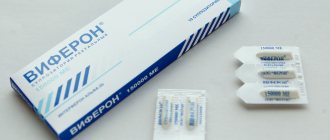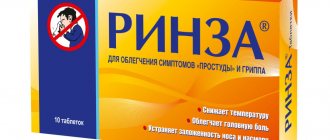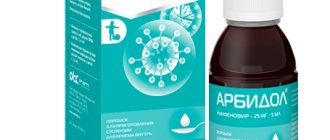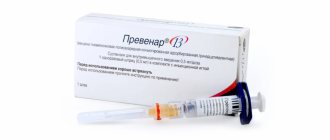Arbidol Maximum - instructions for use
12+ Where to buy
Dosage 200 mg – capsules No. 10 from white or white with a greenish-yellow or cream tint to light yellow or light yellow with a greenish tint.
- Treatment:
200 mg x 4 times a day, 5 days - Post-exposure prophylaxis:
200 mg x 1 time per day, 10–14 days - Seasonal prophylaxis:
200 mg x 2 times a week, 3 weeks
Registration number: LP-002690 dated 10/31/2014
Trade name of the drug: Arbidol® Maximum
International nonproprietary name: Umifenovir
Dosage form: capsules
Composition per capsule:
Active ingredient: umifenovir hydrochloride monohydrate (in terms of umifenovir hydrochloride) – 207 mg (in terms of umifenovir hydrochloride) – 200 mg.
Excipients: potato starch - 45.67 mg, microcrystalline cellulose - 11.20 mg, colloidal silicon dioxide (Aerosil) - 2.80 mg, povidone (kollidon 25) - 7.73 mg, calcium stearate - 2.80 mg, croscarmellose sodium – 2.80 mg, weight of capsule contents – 280 mg.
Hard gelatin capsules No. 0:
Composition of the capsule shell (body and cap): titanium dioxide (E 171) – 1.92 mg, gelatin – 94.08 mg. The total weight of the capsule is 376 mg.
Description
Hard gelatin capsules No. 0, white. The contents of the capsule are a mixture containing granules and powder from white or white with a greenish-yellow or cream tint to light yellow or light yellow with a greenish tint.
Pharmacotherapeutic group: antiviral agent.
ATX code: J05AX13
Pharmacological properties
Pharmacodynamics
Antiviral agent. Specifically suppresses in vitro influenza viruses A and B (Influenza virus A, B), including highly pathogenic subtypes A(H1N1)pdm09 and A(H5N1), as well as other viruses that cause acute respiratory viral infections (ARVI) (coronavirus, associated with severe acute respiratory syndrome (SARS), rhinovirus (Rhinovirus), adenovirus (Adenovirus), respiratory syncytial virus (Pneumovirus) and parainfluenza virus (Paramyxovirus)). In in vitro studies, it specifically inhibits the SARS-CoV-2 virus, which causes novel coronavirus infection (COVID-19). The EC50 (half maximal effective concentration) in Vero E6 cells is 4.11 µM, which corresponds to 2.11 µg/ml. The clinical significance of this requires further study.
According to the mechanism of antiviral action, it belongs to fusion inhibitors, interacts with the hemagglutinin of the virus and prevents the fusion of the lipid membrane of the virus and cell membranes. It has a moderate immunomodulatory effect and increases the body's resistance to viral infections. It has interferon-inducing activity - in a study on mice, the induction of interferons was noted after 16 hours, and high titers of interferons remained in the blood up to 48 hours after administration. Stimulates cellular and humoral immune responses: increases the number of lymphocytes in the blood, especially T-cells (CD3), increases the number of T-helpers (CD4) without affecting the level of T-suppressors (CD8), normalizes the immunoregulatory index, stimulates the phagocytic function of macrophages and increases the number of natural killer (NK) cells.
Therapeutic effectiveness for viral infections is manifested in a decrease in the duration and severity of the disease and its main symptoms, as well as in a decrease in the incidence of complications associated with viral infection and exacerbations of chronic bacterial diseases.
When treating influenza or ARVI in adult patients, a clinical study showed that the effect of the drug in adult patients is most pronounced in the acute period of the disease and is manifested by a reduction in the time for resolution of symptoms of the disease, a decrease in the severity of the manifestations of the disease and a reduction in the time for elimination of the virus.
Therapy with the drug leads to a higher frequency of relief of symptoms of the disease on the third day of therapy compared to placebo - 60 hours after the start of therapy, the resolution of all symptoms of laboratory-confirmed influenza is more than 5 times higher than the same indicator in the placebo group.
A significant effect of the drug on the rate of elimination of the influenza virus was established, which, in particular, was manifested by a decrease in the frequency of detection of viral RNA on the 4th day.
Refers to low-toxic drugs (LD50 > 4 g/kg). Does not have any negative effects on the human body when administered orally in recommended doses.
Pharmacokinetics
Quickly absorbed and distributed throughout organs and tissues. The maximum concentration in blood plasma when taken at a dose of 50 mg is achieved after 1.2 hours, at a dose of 100 mg - after 1.5 hours. Metabolized in the liver. The half-life is on average 17-21 hours. About 40% is excreted unchanged, mainly with bile (38.9%) and in small amounts by the kidneys (0.12%). During the first day, 90% of the administered dose is eliminated.
Indications for use
Prevention and treatment in adults and children over 12 years of age: influenza A and B, other acute respiratory viral infections.
Complex therapy of recurrent herpes infection.
Prevention of postoperative infectious complications.
Complex therapy of acute intestinal infections of rotavirus etiology in children over 12 years of age.
Contraindications
Hypersensitivity to umifenovir or any component of the drug; children up to 12 years of age. First trimester of pregnancy. Breastfeeding period.
Carefully
Second and third trimesters of pregnancy.
Use during pregnancy and breastfeeding
In animal studies, no harmful effects on pregnancy, embryonic and fetal development, labor or postnatal development were identified.
The use of Arbidol® Maximum in the first trimester of pregnancy is contraindicated.
In the second and third trimester of pregnancy, Arbidol® Maximum can be used only for the treatment and prevention of influenza and if the expected benefit to the mother outweighs the potential risk to the fetus. The benefit/risk ratio is determined by the attending physician.
It is not known whether Arbidol® Maximum passes into breast milk in women during lactation. If you need to use Arbidol® Maximum, you should stop breastfeeding.
Directions for use and doses
Inside, before meals.
A single dose for adults and children over 12 years of age is 200 mg (1 capsule).
| Indication | Dosage regimen |
| In adults and children over 12 years of age: | |
| Nonspecific prevention during an epidemic of influenza and other acute respiratory viral infections | in a single dose 2 times a week for 3 weeks. |
| Nonspecific prophylaxis in direct contact with patients with influenza and other acute respiratory viral infections | in a single dose 1 time per day for 10-14 days. |
| Treatment of influenza and other acute respiratory viral infections | in a single dose 4 times a day (every 6 hours) for 5 days. |
| Complex therapy for recurrent herpes infection | in a single dose 4 times a day (every 6 hours) for 5-7 days, then in a single dose 2 times a week for 4 weeks. |
| Prevention of postoperative infectious complications | in a single dose 2 days before surgery, then on days 2 and 5 after surgery. |
| For children over 12 years of age: | |
| Complex therapy of acute intestinal infections of rotavirus etiology | in a single dose 4 times a day (every 6 hours) for 5 days. |
The drug should be taken from the moment the first symptoms of influenza and other acute respiratory viral infections appear, preferably no later than 3 days from the onset of the disease.
If, after using the drug Arbidol® Maximum for three days in the treatment of influenza and other acute respiratory viral infections, the severity of the symptoms of the disease, including high temperature (38 ° C or more), then you must consult a doctor to assess the validity of taking the drug.
Use the drug only according to the indications, method of administration and in the doses indicated in the instructions.
When treating influenza and ARVI, concomitant symptomatic therapy is possible, including taking antipyretic drugs, mucolytics and local vasoconstrictors.
Side effect
The drug Arbidol® Maximum is a low-toxic drug and is usually well tolerated.
Side effects are rare, usually mild or moderate and transient.
The frequency of adverse drug reactions is determined in accordance with the WHO classification: very often (with a frequency of more than 1/10), often (with a frequency of at least 1/100, but less than 1/10), infrequently (with a frequency of at least 1/1000, but less than 1/100), rare (with a frequency of at least 1/10,000, but less than 1/1000), very rare (with a frequency of less than 1/10,000), frequency unknown (cannot be determined from the available data).
Immune system disorders : rarely - allergic reactions.
If any of the side effects indicated in the instructions get worse, or you notice any other side effects not listed in the instructions, tell your doctor.
Overdose
Not marked.
Interaction with other drugs
When prescribed with other drugs, no negative effects were noted.
No special clinical studies have been conducted to study the interactions of the drug Arbidol® Maximum with other drugs.
There was no evidence of undesirable interactions with antipyretic, mucolytic and local vasoconstrictor drugs in a clinical study.
special instructions
It is necessary to follow the regimen and duration of taking the drug recommended in the instructions. If you miss one dose of the drug, the missed dose should be taken as early as possible and continue taking the drug according to the started regimen.
If, after using the drug Arbidol® Maximum for three days in the treatment of influenza and other acute respiratory viral infections, the severity of the symptoms of the disease, including high temperature (38 ° C or more), then you must consult a doctor to assess the validity of taking the drug.
Impact on the ability to drive vehicles and machinery
It does not exhibit central neurotropic activity and can be used in medical practice by people of various professions, incl. requiring increased attention and coordination of movements (transport drivers, operators, etc.).
Release form
Capsules 200 mg.
10 capsules per blister pack made of polyvinyl chloride film and printed varnished aluminum foil.
1 or 2 contour packages with instructions for use are placed in a cardboard pack.
Storage conditions
Store at a temperature not exceeding 25°C. Keep out of the reach of children.
Best before date
2 years. Do not use after the expiration date stated on the packaging.
Vacation conditions
Available without a prescription.
Marketing authorization holder/organization receiving consumer complaints
OTCPharm JSC, Russia 123112, Moscow, st. Testovskaya, 10 fl. 12, room II, room 29 Tel. Fax www.otcpharm.ru www.arbidol.ru
305022, Russia, Kursk, st. 2nd Aggregatnaya, 1a/18, tel./fax, www.pharmstd.ru
Arbidol Maximum caps 200 mg N10 (OTISI)
Antiviral agent. Specifically suppresses in vitro influenza viruses A and B (Influenzavirus A, B), including highly pathogenic subtypes A(H1N1)pdm09 and A(H5N1), as well as other viruses that cause acute respiratory viral infections (ARVI) (coronavirus associated with severe acute respiratory syndrome (SARS), rhinovirus (Rhinovirus), adenovirus (Adenovirus), respiratory syncytial virus (Pneumovirus) and parainfluenza virus (Paramyxovirus)). According to the mechanism of antiviral action, it belongs to fusion inhibitors, interacts with the hemagglutinin of the virus and prevents the fusion of the lipid membrane of the virus and cell membranes. It has a moderate immunomodulatory effect and increases the body's resistance to viral infections. It has interferon-inducing activity - in a study on mice, the induction of interferons was noted after 16 hours, and high titers of interferons remained in the blood up to 48 hours after administration. Stimulates cellular and humoral immune responses: increases the number of lymphocytes in the blood, especially T-cells (CD3), increases the number of T-helpers (CD4) without affecting the level of T-suppressors (CD8), normalizes the immunoregulatory index, stimulates the phagocytic function of macrophages and increases the number of natural killer (NK) cells. Therapeutic effectiveness for viral infections is manifested in a decrease in the duration and severity of the disease and its main symptoms, as well as in a decrease in the incidence of complications associated with viral infection and exacerbations of chronic bacterial diseases. When treating influenza or ARVI in adult patients, a clinical study showed that the effect of the drug in adult patients is most pronounced in the acute period of the disease and is manifested by a reduction in the time for resolution of symptoms of the disease, a decrease in the severity of the manifestations of the disease and a reduction in the time for elimination of the virus. Therapy with the drug leads to a higher frequency of relief of symptoms of the disease on the third day of therapy compared to placebo - 60 hours after the start of therapy, the resolution of all symptoms of laboratory-confirmed influenza is more than 5 times higher than the same indicator in the placebo group. A significant effect of the drug on the rate of elimination of the influenza virus was established, which, in particular, was manifested by a decrease in the frequency of detection of viral RNA on the 4th day. Refers to low-toxic drugs (LD50 > 4 g/kg). Does not have any negative effects on the human body when administered orally in recommended doses.





